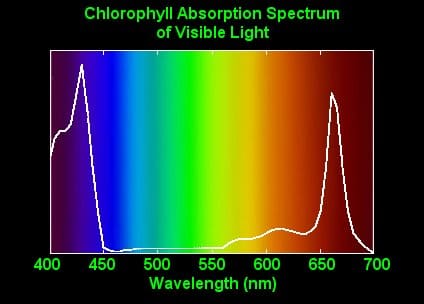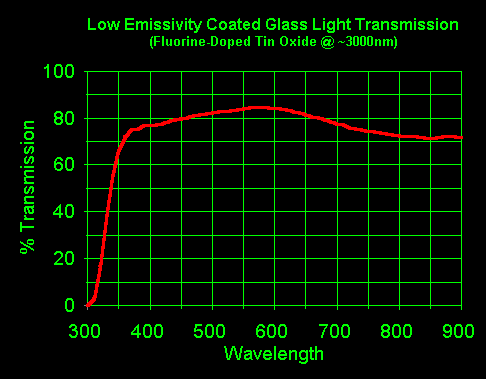Ever wonder why plants are green, or if the tinting in your windows is affecting your plants, or if those cool white fluorescents are really good to grow under?
You know that light exists as a spectrum of different wavelengths, and that each light source emits different intensities of those wavelengths. Likewise, tinting reduces the intensities of the wavelengths differently.
Let’s start by looking at chlorophyll’s absorption spectrum:

Note that chlorophyll absorbs light mostly in the blue and red ends of the visible spectrum, and very little in the green wavelengths. That green light is reflected, giving us the leaf color we see.
It is important to select artificial lighting that provides both ends of the spectrum in sufficient intensity. Household incandescent bulbs are very heavy on the red end, while cool white fluorescents are weak in reds and strong in the blue end. That’s why 50/50 wattages of each can be combined for successful growing. Recent developments in fluorescent phosphors have yielded spectra more like natural sunlight by boosting the red end of their light output.
If you compare that spectrum to the emission spectra of some common household light sources, you’ll see that there is a great deal of variability.
This information is also important to consider when you choose glazing for greenhouses and other growing areas.
Most polyethylene films and polycarbonate panels are quite transparent in the spectral range of interest, but do reduce the overall intensity somewhat evenly across the spectrum. Clear glass has almost an insignificant effect on the light transmitted, from a practical standpoint, but low emissivity glass has a fairly significant impact on the transmitted light.
The coated low-emissivity, or “Low-E” glasses work by blocking the transmittance of long-wave infrared frequencies of the light spectrum. Unfortunately, the coatings that do that also reduce the transmission of light in other parts of the spectrum as well:

Comparing the two curves above, one might conclude that the low-e glass would function as a pretty reasonable 20% – 30% shading glazing material over the 400- to 700 nm spectrum that the chlorophyll absorbs, but there have been reports of growing problems associated with its use. Personally, I question whether the problems were glazing related, but please note that this curve is from a very early generation of low-e glass, and the coatings are much thicker now, so the reduction in transmitted light ought to be significantly greater.
